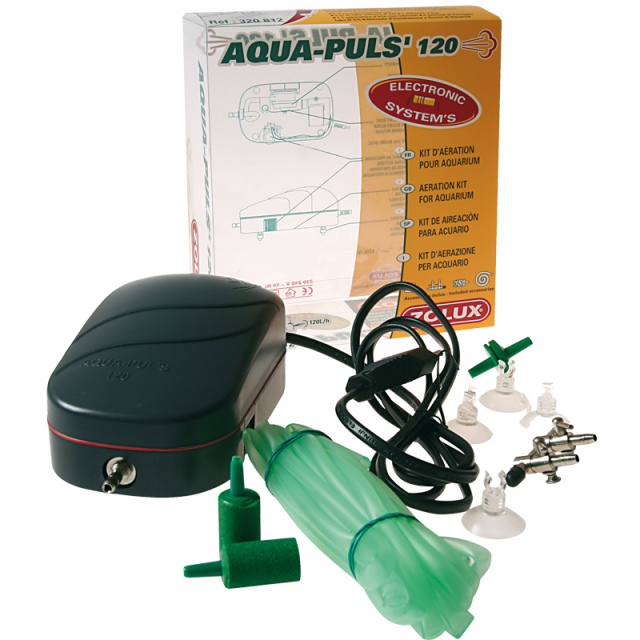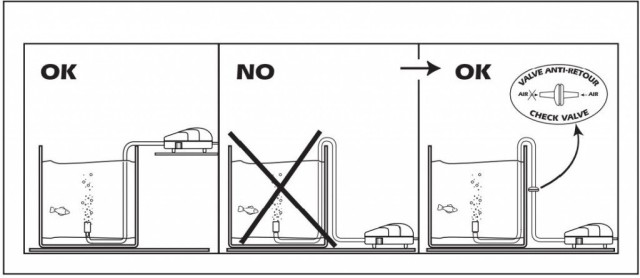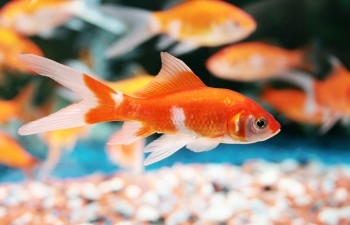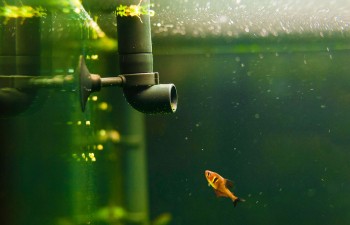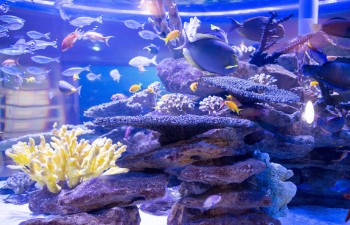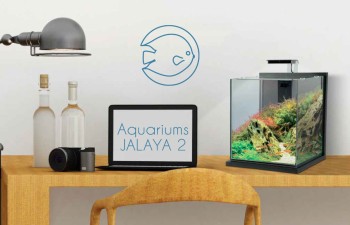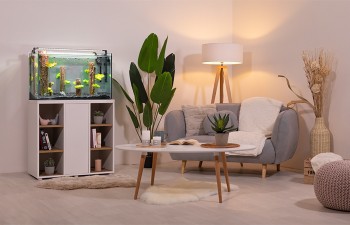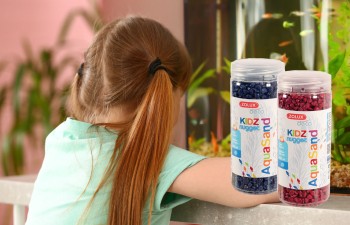
Aquarium aeration
The Principle of Natural Aquarium Oxygenation
The oxygenation of the water is essential to the biological balance of an aquarium and the metabolism of the fish. Oxygen deficiency can be very detrimental to all aquatic flora and fauna and can lead to complete asphyxia in the environment (eutrophication). One of the first visible symptoms of lack of oxygen in the tank is fish “piping” at the water surface.
O2/CO2 Balance:
In an ideal gas exchange cycle between plants and fish in an aquarium, animals obtain oxygen dissolved in the water, which they process, and release carbon dioxide (CO2) On the other hand, under the effect of light (photosynthesis), plants absorb this carbon dioxide, nourishing themselves and converting it into pure oxygen (O2) in the process. So it is this perpetual cycle of exchange and gaseous transformation of oxygen, which will again be consumed by the fish and microbial fauna that is responsible for the biological balance of the environment, and on it goes. However, for this balance to be truly autonomous and functional it is necessary to combine three essential factors: relatively few fish + a large volume of water + substantial vegetation. This perfect combination is rarely achieved in a decorative aquarium – it is often necessary to add an additional oxygenation system.
In practice, oxygenation can be achieved by various technical and chemical processes. The most frequently used is the principle of gas exchange during water mixing (air/water interface).
Since the air is composed of 21% of oxygen and 79% nitrogen (an inert gas), as the air and water come into contact during water mixing the the vital oxygen that all fish and microbial fauna that are responsible for biological purification of the water (see transformation of waste by aerobic bacteria) is replenished.
The optimum value of dissolved oxygen in a tank is about 8 mg/L at a temperature of 25° C
The optimum value of dissolved oxygen in a tank is about 8 mg/L at a temperature of 25° C
The gas absorption capacity of water to achieve an ideal level of oxygen in the aquarium depends mainly on 3 criteria: the force of the water mixing, the physico-chemical quality of the water, and temperature. With respect to temperature, it should be noted that the solubility of oxygen decreases sharply with increasing temperature; the concentration level of dissolved oxygen will be less at 30° than 20° C.
The Main Oxygenation Systems Used in the Aquarium
Air Pump (Bubble Column)
The air pump is a small membrane-based device, simple to operate and relatively quiet, used to introduce air into an aquarium (through bubbling). Surprisingly, it is not the bubble column itself that achieves the oxygenation, but the disturbance created by the bubble column at the water surface (gas exchange).
The oxygenator effect of an air pump is based on the propensity of the oxygen molecules contained in the air to dissolve in the water during mixing, thereby increasing the concentration, up to the point of saturation.
The various functions that may be accomplished by an air pump are: aerating and oxygenating the aquarium; creating an upward flow in the tank; preventing the establishment and spread of a bacterial film on the surface (avoids eutrophication); supports the operation of some internal filters, or skimmer systems in salt water tanks; finally, can create an elegant column of fine bubbles, or activate a fun decoration at the bottom of the aquarium.
An air pump is relatively economical, with low power consumption (from 2 to 15 W). The power you need is determined based on the volume of the tank, the amount of animals in the tank and the number of outputs and tasks you want your pump to handle.
Installation is very simple and the additional aeration accessories offered by Zolux (tubing, all shapes and sizes of diffusers, valves, separators, manifolds, check valves, etc.) can be used to design and create virtually any imaginable combination (see diagram below).
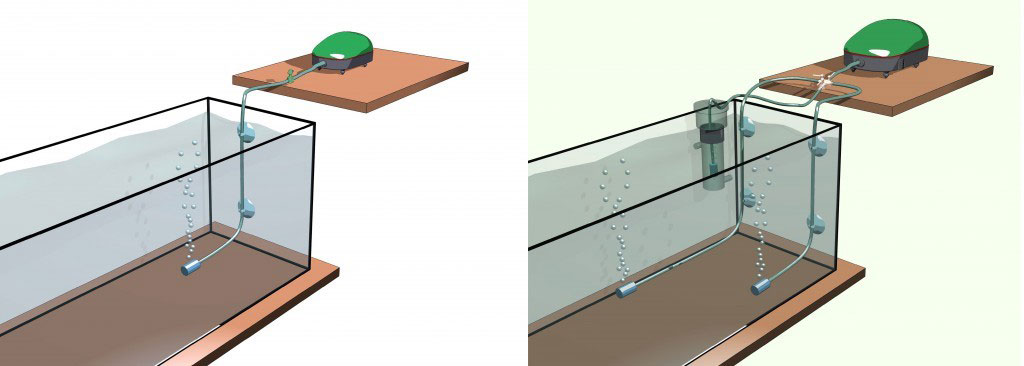
Installation diagrams and multi-channel combinations
Air Compressor
Compressors are very large air pumps membranes. With a capacity of 60 to more than 100 W for an output rate of 4000 to 9000 L/hr (or more), these pumps are designed mainly for professional use: very large aquariums, retaining ponds and other ponds, racks of aquariums (sales or storage), etc.
All ZOLUX pumps and compressors are guaranteed to comply with European Directives for electrical safety and comply with the following standards: LVD (Low Voltage Directive), EMC (electromagnetic compatibility), and RoHS (Restriction of use of certain Hazardous Substances in electrical and electronic equipment).
Surface Water Mixing and the “Venturi System”
Oxygenation by surface water mixing can also be achieved by positioning the discharge pipe of the pump or filter at the surface of the water. The water flow allows gas exchange to occur through the disturbance created at the air/water interface.
Another available oxygenation system is the “Venturi System”. A small accessory that attaches to the filter output, it draws in air with a depression in the upper part (non-immersed) and ejects this air as micro-bubbles in the aquarium. It’s actually a small pressure reactor and a very effective oxygenation system, which is often used in small internal pumps and filters.
Trickle Filter
Also called a “semi-wet” or “wet-dry” filter, this filtration technique is mainly used on large, technically sophisticated aquariums. The trickle filter is an “overflow” filter generally located below the aquarium. The filtration media, open to the air and often located in drawers, get water from the aquarium as a trickle, much like rain. This technique provides maximum air/water gas exchange and a dissolved oxygen rate that is always fully saturated in the filtration media (these are particularly favourable conditions for good bacterial growth and highly effective biological purification).
Oxygenation of the Environment via Intake and Processing of Carbon Dioxide
Introducing carbon dioxide (CO2) in a freshwater aquarium not only helps the growth and lush development of vegetation, it is also an extremely effective method of oxygenating the water, without any additional introduction of air or water mixing.
In this case, the plants avidly consume CO2 present in the water through photosynthesis (during the period of illumination) and convert it into pure oxygen. This oxygen is then immediately diluted in water and thus provides natural hyper-oxygenation of the tank environment.
For Nanos and other small tanks of less than 100 L, CO2 distributors that are very simple to set up and manage are available on the market (see illustration).
Despite the fact that it is a little tricky and requires relatively sophisticated equipment (that can be electronically self-managed), this method is often used by aquarium enthusiasts for large tanks with lots of vegetation (“Dutch” or “Japanese” style aquariums).
Oxidizing Agents (chemical reaction from hydrogen peroxide)
There are some commercially available chemical oxygenation systems based on hydrogen peroxide. These require no tubing connections, no electricity and of course are completely silent. They operate from a supply of “hydrogen peroxide” (H2O2), activated by one or more catalysts, depending on which system is used.
Although they can be rather difficult to manage, these devices might be suitable in the specific case of aquariums with no power source, or with little or no possibility of mixing the air/water interface (eg, a closed table aquarium).

